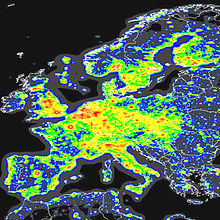

Skyglow (or sky glow) is the diffuse luminance of the night sky, apart from discrete light sources such as the Moon and visible individual stars. It is a commonly noticed aspect of light pollution. While usually referring to luminance arising from artificial lighting, skyglow may also involve any scattered light seen at night, including natural ones like starlight, zodiacal light, and airglow.[1][2]
In the context of light pollution, skyglow arises from the use of artificial light sources, including electrical (or rarely gas) lighting used for illumination and advertisement and from gas flares.[3] Light propagating into the atmosphere directly from upward-directed or incompletely shielded sources, or after reflection from the ground or other surfaces, is partially scattered back toward the ground, producing a diffuse glow that is visible from great distances. Skyglow from artificial lights is most often noticed as a glowing dome of light over cities and towns, yet is pervasive throughout the developed world.
- ^ Roach, Franklin E. & Gordon, Janet L. (1973). The Light of the Night Sky. Dordrecht and Boston, Massachusetts: D. Reidel.
- ^ Flanders, Tony (December 5, 2008). "Rate Your Skyglow". Sky & Telescope. AAS Sky Publishing. Retrieved 2020-02-26.
- ^ Guerin, Emily (5 November 2015). "Oil Boom Means Sky Watchers Hoping for Starlight Just Get Stars, Lite". NPR. Retrieved 2016-04-24.